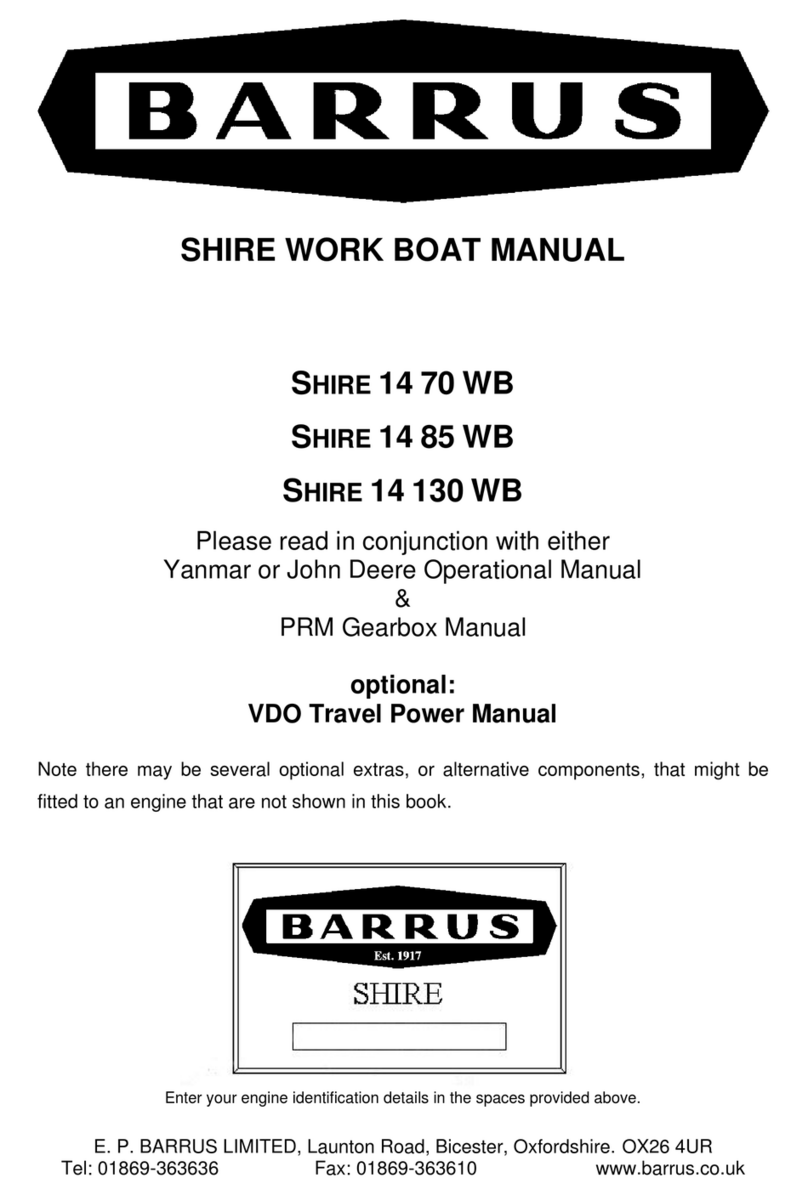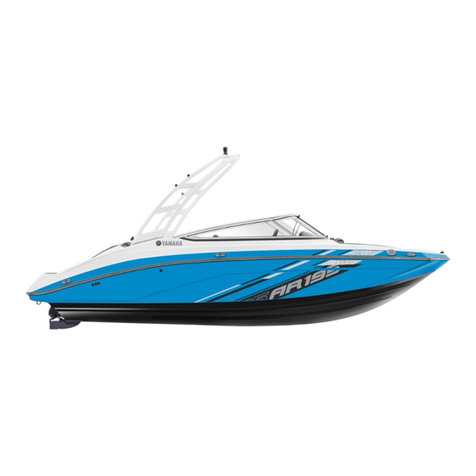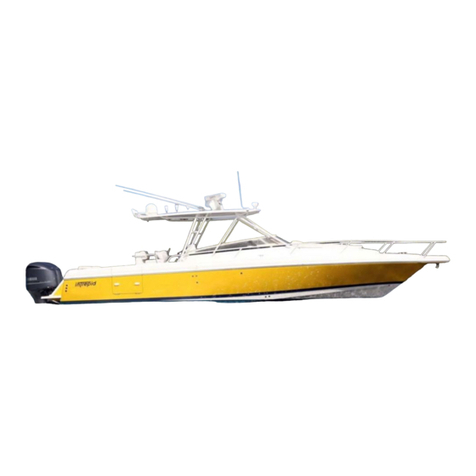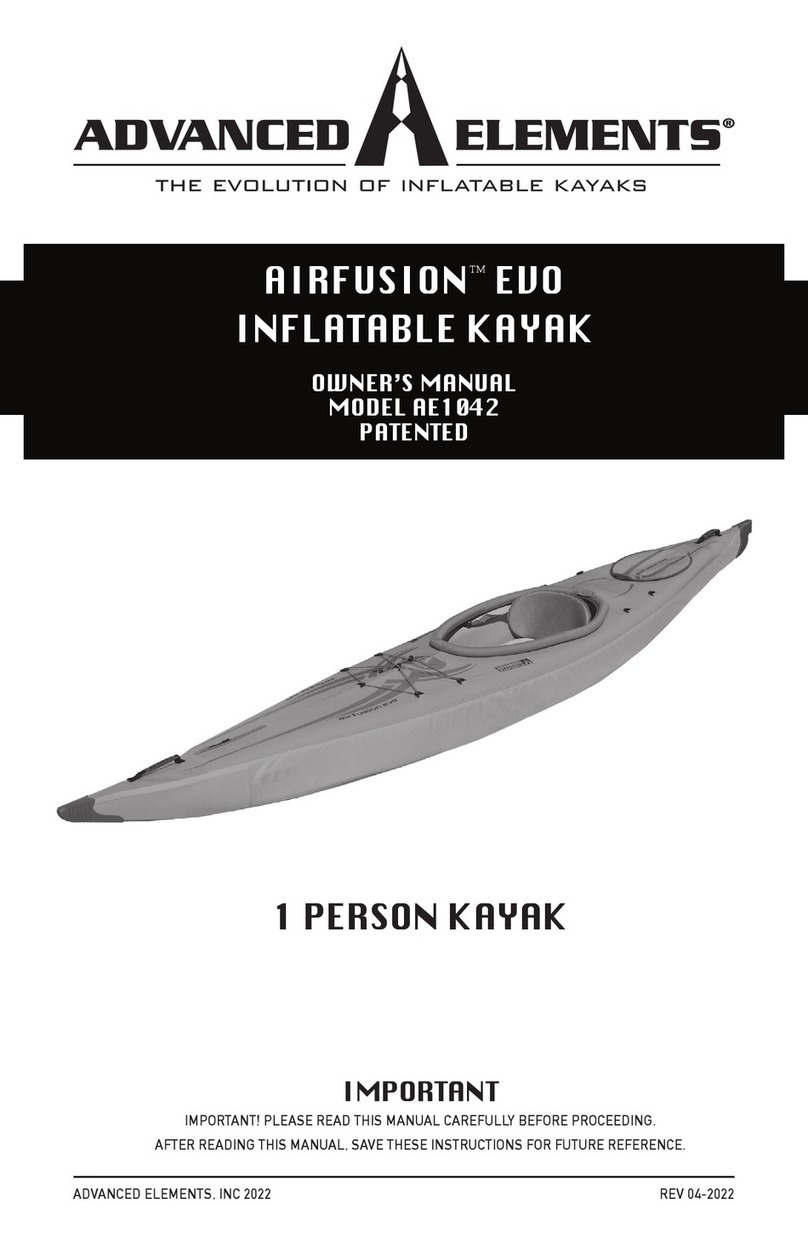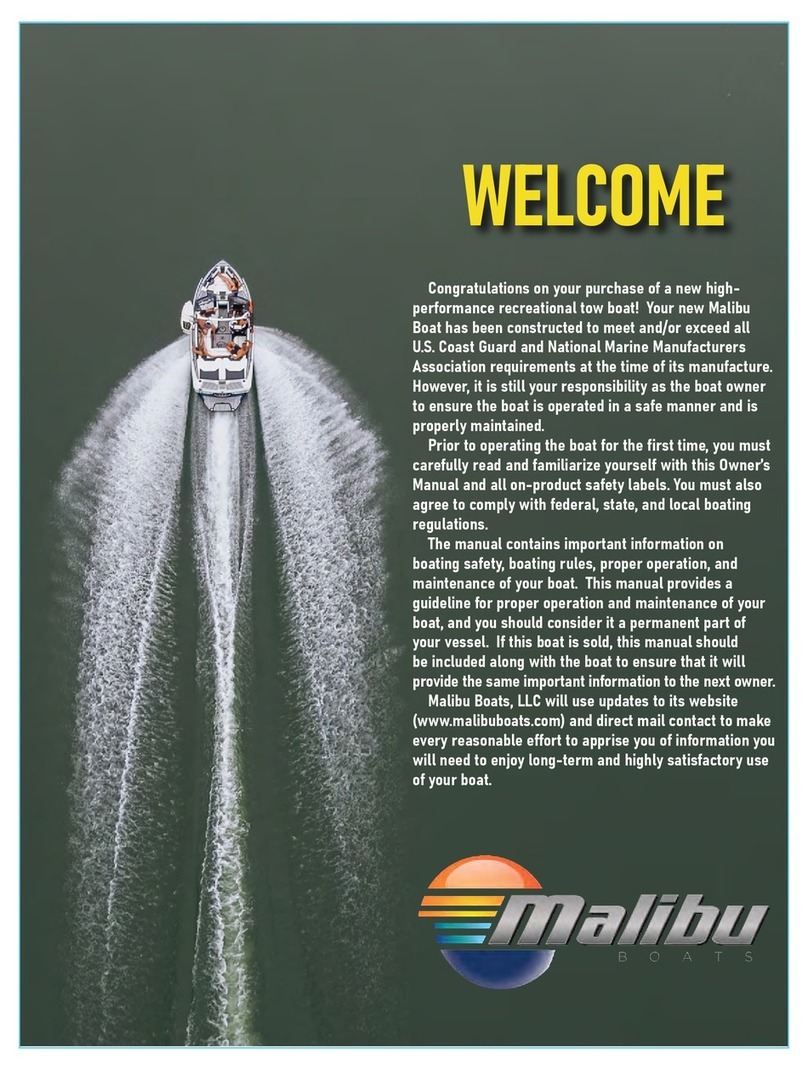Barrus SHIRE 14 85 WB User manual

SHIRE WORK BOAT MANUAL
SHIRE 14 85 WB
SHIRE 14 130 WB
ISSUE 10
Please read in conjunction with
John Deere Operational Manual
&
PRM Gearbox Manual
optional:
VDO Travel Power Manual
Note there may be several optional extras, or alternative components, that might be
fitted to an engine that are not shown in this book.
Enter your engine identification details in the spaces provided above.
E. P. BARRUS LIMITED, Launton Road, Bicester, Oxfordshire. OX26 4UR

RDG603A11 - Issue 10 - Shire 14 85, 130 WB Owners Manual Page 2 of 52
Tel: 01869-363636 Fax: 01869-363610 www.barrus.co.uk
PLEASE NOTE:
This manual has been compiled to help you to operate your engine and its associated
parts with safety and pleasure. Please read it carefully and familiarise yourself with the
engine and its parts before operation.
E.P.Barrus reserve the right to change the specification of its products and manuals
without prior notice.
Depending upon the equipment specification of the engine and accessories fitted, there
may be discrepancies with the information presented in this handbook. No claims may
be pursued in this respect.
WARNING:
THIS MANUAL FORMS AN INTEGRAL PART OF THE ENGINE IT ACCOMPANIES,
IF A TRANSFER OF TITLE OCCURS, IT MUST ALWAYS BE HANDED OVER TO THE
NEW OWNER.
WARRANTY
This Limited Warranty provides coverage for three (3) years (or 2000 hours which ever
occurs first) for commercial users from the date of warranty registration. The repair or
replacement of parts, or the performance of service under this warranty, does not
extend the life of this warranty beyond its original expiry date.
PRM gearboxes are covered by a two (2) year warranty.
To ensure that you have been registered for your warranty, please ask your Boat-
Builder or Engine supplier to provide your portion of the registration form.
The Warranty will only apply if the following have been carried out:
1/ The Installation Check List in the Installation Section has been fully completed.
2/ The boat builder or engine installer has completed the Boat Builder Section on the
Service Record Card (located at the back of this manual) regarding hand over and
commissioning of boat.
3/ The registration form has been completed and returned to E.P Barrus.
Engine alternator, starter motor and electrical components are only covered by a one
(1) year warranty.

RDG603A11 - Issue 10 - Shire 14 85, 130 WB Owners Manual Page 3 of 52
CONDITIONS THAT MUST BE MET IN ORDER TO OBTAIN WARRANTY COVERAGE
Warranty coverage is only available from an authorised dealer in the country in which
the sale occurred. Routine maintenance outlined in the Owners Manual must be
performed using genuine parts in order to maintain warranty coverage. If the customer
performs maintenance, Barrus reserves the right to make future warranty coverage
possible only with proof of proper maintenance.
WARRANTY CLAIMS
Warranty claims shall be made by an authorised dealer or boat builder.
The dealer or boat builder will then arrange for the inspection and any necessary
repairs. If the repairs carried out are not covered by the warranty, purchaser shall pay
for all related labour and material, and any other expenses associated with that service.
WHAT IS NOT COVERED
This limited warranty does not cover routine maintenance items, adjustments, normal
wear and tear, damage caused by abnormal use, operation of the product in a manner
inconsistent with the recommended operation/duty cycle section of the Owners Manual,
accident, submersion, improper installation (proper installation specification and
techniques are set forth in the Operations and First time running sections in this
manual), use of an accessory or part not manufactured or sold by us, or alteration or
removal of parts. Expenses related to crane-out, launch, towing, storage, telephone,
rental, inconvenience, slip fees, insurance coverage, loan payments, loss of time, loss
of income, or any other types of accidental or consequential damages are not covered
by this warranty.
Failure to use John Deere approved oils and coolants will invalidate any warranty.
Engine electrical systems fitted with alternator boost charge systems or any other
electrical management systems other than those approved by Barrus are not covered
by warranty.
Engine and fuel equipment is not covered by warranty if bio-diesel is used in the fuel
system. Also if no type of water trap is incorporated into fuel system.
Damage due to rust or corrosion, submersion, or unreasonable exposure to the
environment, such as exposure to high humidity, rain fall, or seawater, or conditions
resulting in the freezing of cooling water are also not covered.

RDG603A11 - Issue 10 - Shire 14 85, 130 WB Owners Manual Page 4 of 52
Dirty Fuel:
Engines that do not operate correctly as a consequence of using fuel that is not of the
correct grade, or is contaminated with either dirt, water or biological growth, is not
covered by warranty. Also, any replacement parts that are required as a consequence
of using incorrect or contaminated fuel are also not covered by warranty. Engine Fuel
Injection equipment is only covered by warranty for the period of three years.

RDG603A11 - Issue 10 - Shire 14 85, 130 WB Owners Manual Page 5 of 52
Contents
SECTION 1 - SAFETY PRECAUTIONS .................................................................................... 7
1. General ...................................................................................................................... 7
2. Lifting ......................................................................................................................... 7
3. Rotating Shafts and Belts ........................................................................................... 7
4. Exhaust System ......................................................................................................... 8
5. Launching and Lifting Boats ....................................................................................... 8
6. Batteries..................................................................................................................... 9
SECTION 2 - ENGINE IDENTIFICATION ................................................................................ 10
SECTION 3 - INSTALLATION ................................................................................................. 11
1. Ventilation ................................................................................................................ 11
2. Engine Beds............................................................................................................. 11
3. Pressurised Water Header Tank .............................................................................. 11
4. Shaft Connection and Propeller selection................................................................. 13
5. Engine Anti-Vibration Mounts ................................................................................... 13
6. Engine Mount Installation ......................................................................................... 14
7. Engine Alignment ..................................................................................................... 15
8. Engine Inclination..................................................................................................... 16
9. Electrics ................................................................................................................... 16
10. Electrical Options ..................................................................................................... 17
11. Belt Replacement..................................................................................................... 18
12. Engine Oil ................................................................................................................ 19
13. Fuel.......................................................................................................................... 20
14. Coolant..................................................................................................................... 21
15. Calorifier (optional) ................................................................................................... 22
16. Control Cables ......................................................................................................... 22
17. Domestic Battery Bank (with optional Twin Alternator Engines)................................ 23
18. Control Panel ........................................................................................................... 24
19. Seawater Strainer..................................................................................................... 25
20. Exhaust System (Dry Exhaust)................................................................................. 25
21. Hydraulic Drive Transmissions ................................................................................. 28
22. Engine Start Battery ................................................................................................. 28
23. Installation Check list................................................................................................ 29
SECTION 4 –OPERATION ..................................................................................................... 30
1. Starting The Engine For The First Time.................................................................... 30
2. Starting Procedure ................................................................................................... 30
3. Stopping Procedure.................................................................................................. 31
4. Refuelling ................................................................................................................. 31
5. Diesel Fuel Additive.................................................................................................. 32
6. Exhaust Back Pressure ............................................................................................ 32
7. Shifting in and out of gear......................................................................................... 32
SECTION 5 - SERVICE PROCEDURE .................................................................................... 33
1. Engine Oil and Filter Change ................................................................................... 33
2. Air Filter Check & Change ........................................................................................ 34
3. Gearbox Oil Change................................................................................................. 34
4. Disposal of Oil and Related Items ............................................................................ 35
5. Primary Fuel Filter Water Drain ................................................................................ 36
6. Primary Fuel Filter Change....................................................................................... 37
7. Secondary Fuel Filter Change.................................................................................. 37
8. Fuel System Bleeding .............................................................................................. 37

RDG603A11 - Issue 10 - Shire 14 85, 130 WB Owners Manual Page 6 of 52
9. Cooling System ........................................................................................................ 38
10. Belt Adjustment (Twin Alternators) ........................................................................... 38
11. Belt Maintenance...................................................................................................... 39
12. Belt Replacement..................................................................................................... 40
13. Deluxe Panel Maintenance....................................................................................... 41
14. Sacrificial Anode Change ......................................................................................... 41
15. Raw Water Pump Impeller Change .......................................................................... 42
16. Engine Heat Exchanger Tube Stack Flushing. ......................................................... 42
17. Winterization of Seawater Cooling System. .............................................................. 42
SECTION 6 - SERVICE PARTS............................................................................................... 43
SECTION 7 - SERVICE SCHEDULE ....................................................................................... 44
SECTION 8 - WIRING DIAGRAMS.......................................................................................... 45
1. Engine Wiring Diagram, Shire 14 85/130 WB........................................................... 46
2. Deluxe Control Panel Wiring Diagram ...................................................................... 47
3. RDG20710111 - Deluxe Control Panel..................................................................... 48
4. 5kW VDO Travel Power System............................................................................... 48
SECTION 9 –AFTERLIFE RECYCLING ................................................................................. 49
SECTION 10 - DEALER LIST .................................................................................................. 50
SERVICE RECORD CARD...................................................................................................... 52

RDG603A11 - Issue 10 - Shire 14 85, 130 WB Owners Manual Page 7 of 52
SECTION 1 - Safety Precautions
1. General
It is the responsibility of the installer/operator to ensure that the finished installation
complies with the relevant health & safety requirements and or any other legislative
requirements before commissioning.
Ensure that the engine battery isolator switch is in the off position and the key removed
from the control panel before carrying out any maintenance or repairs.
Ensure that all installations and boat alterations comply with any appropriate local,
regional, national or international regulations. When installing new propulsion systems
(that are not identical to the original ones) into existing craft, a new vessel Post
Construction Assessment will be required, and carried out by an independent notified
body.
2. Lifting
DANGER: CRUSH HAZARD!
NEVER STAND UNDER A HOISTED ENGINE. IF THE HOIST MECHANISM FAILS,
THE ENGINE WILL FALL ON YOU, CAUSING SERIOUS INJURY OR DEATH.
The lifting points supplied with the engine are for lifting the engine/gearbox only. A
suitable spreader bar must be employed to prevent over-stressing either bracket during
any lift.
3. Rotating Shafts and Belts
WARNING:
SEVERE HAZARD! KEEP HANDS AND OTHER BODY PARTS AWAY FROM
MOVING/ROTATING PARTS. WEAR TIGHT FITTING CLOTHING AND KEEP YOUR
HAIR SHORT OR TIE BACK. REMOVE ALL JEWELLERY BEFORE COMMENCING
WORK. CHECK BEFORE STARTING THE ENGINE THAT ANY TOOLS OR RAGS
USED DURING MAINTENANCE HAVE BEEN REMOVED FROM THE AREA.
The engine and its accessories are not intended to be put into operation until it is
integrated into the boat as a whole. No person should be in the engine compartment
whilst the engine is running.

RDG603A11 - Issue 10 - Shire 14 85, 130 WB Owners Manual Page 8 of 52
4. Exhaust System
WARNING:
EXHAUST HAZARD! NEVER OPERATE ENGINE IN A BOATS ENGINE BAY
WITHOUT PROPER VENTILATION. NEVER BLOCK VENTS OR OTHER MEANS OF
VENTILATION. ALL COMBUSTION ENGINES CREATE CARBON MONOXIDE GAS
DURING OPERATION. ACCUMULATION OF THIS GAS COULD CAUSE ILLNESS OR
EVEN DEATH.
WARNING:
BURN HAZARD! WAIT UNTIL THE EXHAUST COOLS BEFORE YOU TOUCH IT.
Exhaust gases may have temperatures as high as 650oc and contain elements which
are harmful if ingested. It is therefore essential that exhaust systems are gas tight and
lagged to prevent accidental burning.
5. Launching and Lifting Boats
Care must be taken when launching or craning new boats into or out of the waterway,
so that water does not enter the engine via the exhaust system or air vents. It is
recommended that these are blocked temporarily whilst undertaking this procedure.

RDG603A11 - Issue 10 - Shire 14 85, 130 WB Owners Manual Page 9 of 52
6. Batteries
DANGER:
EXPLOSIVE GASES
EXPLOSION HAZARD! NEVER SHORT OUT THE BATTERY TERMINALS,
INCLUDING WHEN CHECKING THE REMAINING BATTERY CHARGE THIS WILL
RESULT IN A SPARK AND MAY CAUSE AN EXPLOSION OR FIRE.
WARNING:
BURN HAZARD! BATTERIES CONTAIN SULPHURIC ACID. NEVER ALLOW
BATTERY FLUID TO COME IN CONTACT WITH SKIN, EYES OR CLOTHING.
SEVERE BURNS COULD RESULT. MAKE SURE THE CORRECT PERSONAL
PROTECTION EQUIPMENT IS WORN.
•Batteries can produce explosive gases, keep sparks and flames away from the
battery.
NO SMOKING
•Batteries contain sulphuric acid; if splashed on skin or eyes, flush well with water
and seek medical advice.
•Keep the battery tops and battery compartment ventilated at all times.
•If disconnecting the battery; remove the earth lead FIRST; and re-connect it last.
•If charging the battery; ensure that the charger is switched off before connecting and
disconnecting.
•Do not tip the battery on its side.
•Please see label on battery or manufacturer’s instructions for specific information.

RDG603A11 - Issue 10 - Shire 14 85, 130 WB Owners Manual Page 10 of 52
SECTION 2 - Engine Identification
Please quote the engine identification number during any enquiry or when ordering
spare parts.
This is found engraved into the brass plate, on top of the engine rocker cover and
stamped to the crankcase above the starter motor.
An example of the engine identification plate is as follows:
Figure 2-1: Engine Identification Badge
Note: There are a number of optional extras that may be fitted to an engine for
particular customer’s engine that are not listed here.
A list of common item service part numbers can be found in Shire service parts, in
Section 6 Service Parts.

RDG603A11 - Issue 10 - Shire 14 85, 130 WB Owners Manual Page 11 of 52
SECTION 3 - Installation
1. Ventilation
•All internal combustion engines radiate heat and require cool, clean air for complete
combustion purposes.
•Please ensure that adequate engine room ventilation is provided, by fitting at least
two vents of an aperture of not less than 15,000 mm2each (24 in2).
An allowance must be made for any grills or louvres placed in the
airflows and generally, an increase of 25% in area is sufficient to overcome any
restriction problems.
2. Engine Beds
•These should be a minimum of 10mm thick and extended rearward and be welded
to the hull and forward to the bulkhead. There must be webs or gussets welded in
place midway to prevent flexing. They may be steel or stainless steel glassed into a
GRP hull.
3. Pressurised Water Header Tank
•The pressurised header tank should be mounted higher than the level of the engine
and no more than 1 metre and not less than 300mm from the engine, to prevent
cooling system air locks.
•Shire 14 85 WB - The smaller internal diameter hose tail (left side of tank) should be
connected to the top of the engine. This is the air-bleed. The larger internal diameter
hose-tail (right side of tank) should be connected to the lower pipe on the engine
(circled left). This is the water-fill. The hoses MUST be connected correctly. A
constant rise on pipework is required to prevent air locks
See Figures 3-1 and 3-2

RDG603A11 - Issue 10 - Shire 14 85, 130 WB Owners Manual Page 12 of 52
Figure 3-1: Shire 14 85 WB Header Tank Connections (Crank mounted pump)
Figure 3-2: Shire 14 85/130 WB Header Tank Connections (Belt Driven Pump)

RDG603A11 - Issue 10 - Shire 14 85, 130 WB Owners Manual Page 13 of 52
4. Shaft Connection and Propeller selection
•Some type of flexible coupling must be used to connect the gearbox output flange to
the propeller shaft flange. Various coupling flanges are widely available to assist with
this.
•Please note, underperforming engines will not be covered under warranty if the
cause of the poor performance is found to be the use of an inappropriate propeller.
5. Engine Anti-Vibration Mounts
•Ensure that the engine feet do not end up at the top of the thread on the engine
mounts, this puts undue pressure on them and can result in excessive engine
movement and premature mount failure. Mount the engine using the steel packing
plates supplied under the engine mounts RDG3906, see general arrangement
drawings.
•Ensure that the engine has been installed for at least 24 hours before shaft
alignment is checked, this allows the mounts time to settle under the engine weight.
•Ensure that the anti-vibration mount centre screw is sufficiently raised so as not to
touch the engine bed. If this occurs excessive engine vibration will be experienced
through the hull.
•For best results, fit the front anti vibration mounts into the front holes in the engine
rails. If engine room space is a problem the mounts can be fitted slightly further back
in alternative holes, and the front of the rail cut off –leaving 50mm of material to
retain strength (measuring from the centre of the mount hole to the front end of the
rail). Note: this procedure is only possible on non E Kit/VDO TravelPower engines,
and may result in a very slight increase in vibration. The hole positions are show in
Figure 3-6.
•The Anti Vibration mounts have a small number stamped into them, a Shire 14 85
has “55”(Shore Hardness), and a Shire 14 130 has “65”(Shore Hardness). For Part
Numbers, see the Service Parts section.

RDG603A11 - Issue 10 - Shire 14 85, 130 WB Owners Manual Page 14 of 52
6. Engine Mount Installation
Figure 3-3: Correct Anti-Vibration Mount Installation
•Care should taken to install mounts parallel to the engine rails with the washer and
locknut firmly tightened on the cover of the mount. The maximum distance from the
top of the locknut to the base of the adjusting nut must not exceed 5mm; any greater
adjustment should be made using shims.
Figure 3-4: Correct Anti-Vibration Mount Installation

RDG603A11 - Issue 10 - Shire 14 85, 130 WB Owners Manual Page 15 of 52
Figure 3-5: Anti-Vibration Mount Installation Points
7. Engine Alignment
•The gearbox output shaft flange and propeller shaft input flange must be almost
perfectly aligned. A maximum of 0.05mm (0.002") misalignment in any plane is
acceptable. Ensure alignment is rechecked after the first 4 hours of running, at the
end of the first month and annually thereafter.
•If the engine is out of alignment it will result in excessive vibration and possible
damage to the stern tube and propeller shaft.
•Boats that are fitted with fully flexible drive couplings should still have the engine and
shaft alignment as close as possible. A dummy shaft may be required for this
purpose.
Some types of flexible shaft couplings require the input and output to be
misaligned, check with the coupling manufacturer’s installation instructions.
Normal mounting position.
Alternative mounting position if
engine compartment space is
restricted.

RDG603A11 - Issue 10 - Shire 14 85, 130 WB Owners Manual Page 16 of 52
8. Engine Inclination
•The engine installation angle is the angle of the crankshaft centre to the water line
(Figure below).
•The Propulsion Efficiency decreases as the engine installation angle increases
•The maximum engine installation angle is 15°.
Figure 3-6: Maximum Engine Installation Angle
9. Electrics
WARNING:
The blue link wire must be removed when the domestic battery positive terminal lead has
been connected to the terminal post.
Do not run the engine without this wire in place or without the domestic battery positive lead
connected otherwise alternator damage will occur.
If the engine is going to run for more than 1 hour with the blue link wire in place, remove
domestic alternator drive belt to prevent alternator damage.
•If an optional larger output alternator, or 24V equipment, is fitted to either a new
engine, or fitted to an old engine as an upgrade, ensure that all cables, master switches,
terminals, split charge relays etc are of sufficient capacity for the increased
current/voltage.
•Do not attach any part, hose or cable to the engine wiring harness. There is a
warning label attached to the harness to remind you of this.
Water Line
Engine Installation Angle
MAX 15°

RDG603A11 - Issue 10 - Shire 14 85, 130 WB Owners Manual Page 17 of 52
Single Alternators
•On engines fitted with single alternators, connect the main positive battery cable to
the starter motor solenoid terminal.
•Do not attach any part, hose, or cable to the engine wiring harness. There is a
warning label attached to the harness to remind you of this.
•Connect the wiring extension harness multi plug to the panel plug, and the other end
to the engine.
•Connect the start battery positive cable to the engine starter motor solenoid terminal.
•Starter motor battery cable size to be a minimum of 50mm2.
Twin Alternators
•Shire 14 85/130WB - Connect the domestic battery positive cable to the 120A
alternator B+ terminal (see wiring diagram). This ensures that the 140A charges the
start battery.
•Use 50mm2cable for 240A alternator and 40mm2cable for 140A
•Both negative battery terminals can be connected to a common earth point.
10. Electrical Options
•If the engine is fitted with the optional 230V VDO travel power system, refer to the
manual supplied with it for correct wiring, control box installation and operation.
•The Shire range can be supplied with other optional additional 12v or 24v
alternators. A 24 V Alternator will be supplied fitted but not wired. It is the
responsibility of the boat builder to ensure that this is correctly wired to the boats
electrical system.
•If an optional 24V equipment is fitted to either a new engine, or fitted to an old
engine as an upgrade, ensure that all cables, master switches, terminals, split
charge relays etc are of sufficient capacity for the increased current/voltage.

RDG603A11 - Issue 10 - Shire 14 85, 130 WB Owners Manual Page 18 of 52
11. Belt Replacement
•Ensure that you have the correct new belt prior to starting this procedure. Loosen
the top adjuster bolts, and the lower mounting pivot nut and bolt.
•Push the alternator towards the engine to loosen the belt.
•Remove the seawater pump (may not be required, depending on seawater pump
option fitted).
•Remove the belt.
•Hold the belt in position over the top alternator pulley; rotate the engine, if
required, by hand, to guide the new belt into the pulley “V”s check it is correctly
seated in the pulley.
•Replace seawater pump (if required).
•Re-tension the belt as above.
Note: Some engines maybe fitted with a side mounted belt driven seawater pump.
A similar belt tightening procedure will apply for this.
CAUTION:
REMOVE THE IGNITION KEY BEFORE WORKING IN ENGINE COMPARTMENT.

RDG603A11 - Issue 10 - Shire 14 85, 130 WB Owners Manual Page 19 of 52
12. Engine Oil
WARNING:
BURN HAZARD! WAIT UNTIL THE ENGINE COOLS BEFORE YOU DRAIN THE
ENGINE OIL. HOT ENGINE OIL MAY SPLASH AND BURN YOU.
WARNING:
ENGINE OIL WITH A HIGHER API CLASS THAN SPECIFIED IS UNSUITABLE FOR
BOAT ENGINE OPERATION AND WILL CAUSE ENGINE DAMAGE IF USED.
•All Shire engines are supplied fully run in.
•Check oil levels in engine and gearbox before starting. (The gearbox uses the same
grade of oil as the engine).
•Shire 14 85/130 WB - use John Deere engine oil, part number VC50002X020 “Plus
50 II Oil (20 Litres)”, or alternatively VC83070-020 “Torq-Gard Supreme (20 Litres)”,
available from Barrus.
•Avoid mixing different types of oil as the additives may interfere with each other.

RDG603A11 - Issue 10 - Shire 14 85, 130 WB Owners Manual Page 20 of 52
13. Fuel
WARNING:
DIESEL FUEL IS FLAMMABLE AND EXPLOSIVE UNDER CERTAIN CONDITIONS.
WARNING:
DIESEL FUEL IS HARMFUL TO SKIN. MAKE SURE THE RELEVANT PERSONAL
PROTECTION EQUIPMENT IS WORN.
•Ensure the main fuel tank is clear of dirt & water.
•A separate water trap must be fitted to all engine installations. (The engine is
supplied with a small water trap as standard).
•Connect fuel feed and return hoses from engine to main fuel tank via supply and
return lines. Ensure that they are connected the correct way around.
•Shire 14 85/130 WB –connect to the inlet to the primary fuel filter inlet hose.
•The fuel supply and return hoses are fitted with 10mm (3/8”) hose tails.
•The engine hoses should have sufficient slack to absorb engine movement without
placing strain on the hoses, and be securely clipped to prevent accidental damage
and chafing.
•Initially fill the fuel system loosening the bleed bolt on the top of the primary fuel
filter/water trap. For Shire 14 85/130 WB, pump the primer on the primary filter.
Close when fuel begins to flow clearly (no bubbles). It is rarely necessary to bleed
the injection pump or injectors upon installation as the engine will already have fuel
in it from the engine run-in and test procedure.
This manual suits for next models
1
Table of contents
Other Barrus Boat manuals
Popular Boat manuals by other brands

Ship Harbor Yacht Charters
Ship Harbor Yacht Charters Mary K Operation manual

Fountaine Pajot
Fountaine Pajot ELBA 45 owner's manual
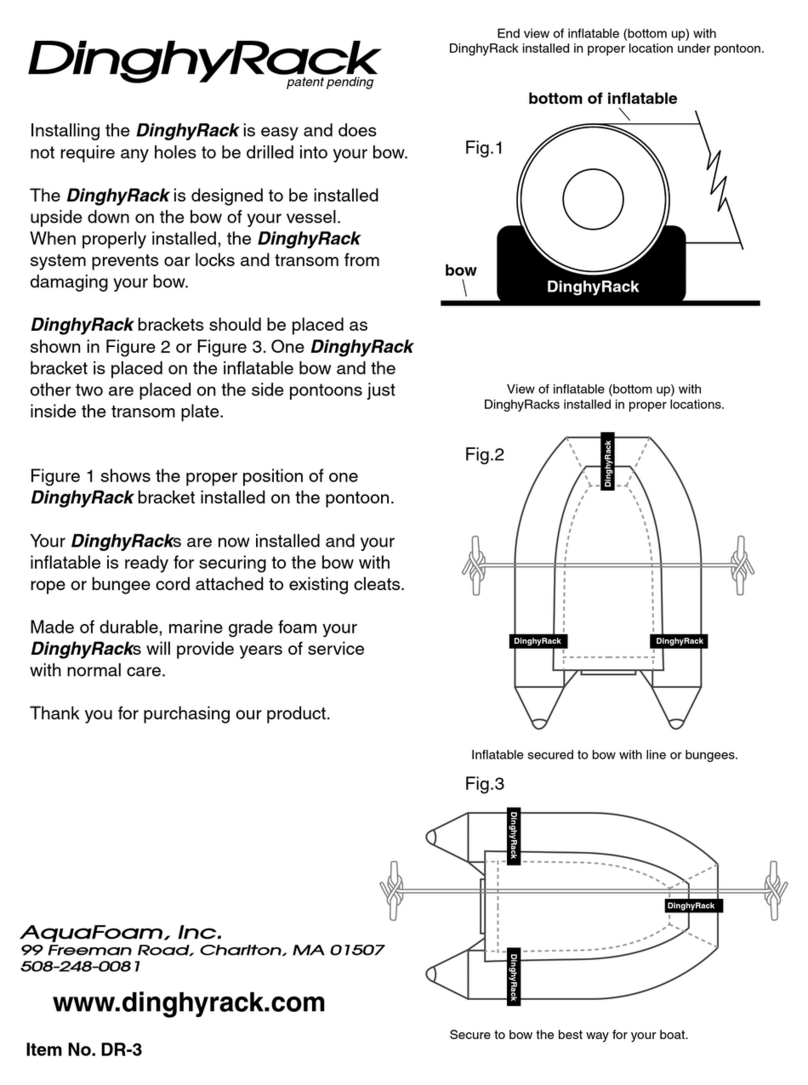
AquaFoam
AquaFoam DinghyRack instructions
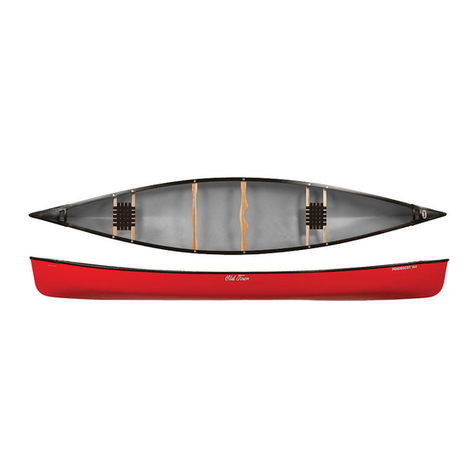
Old Town Canoe Co.
Old Town Canoe Co. 01.1315.2380 owner's manual
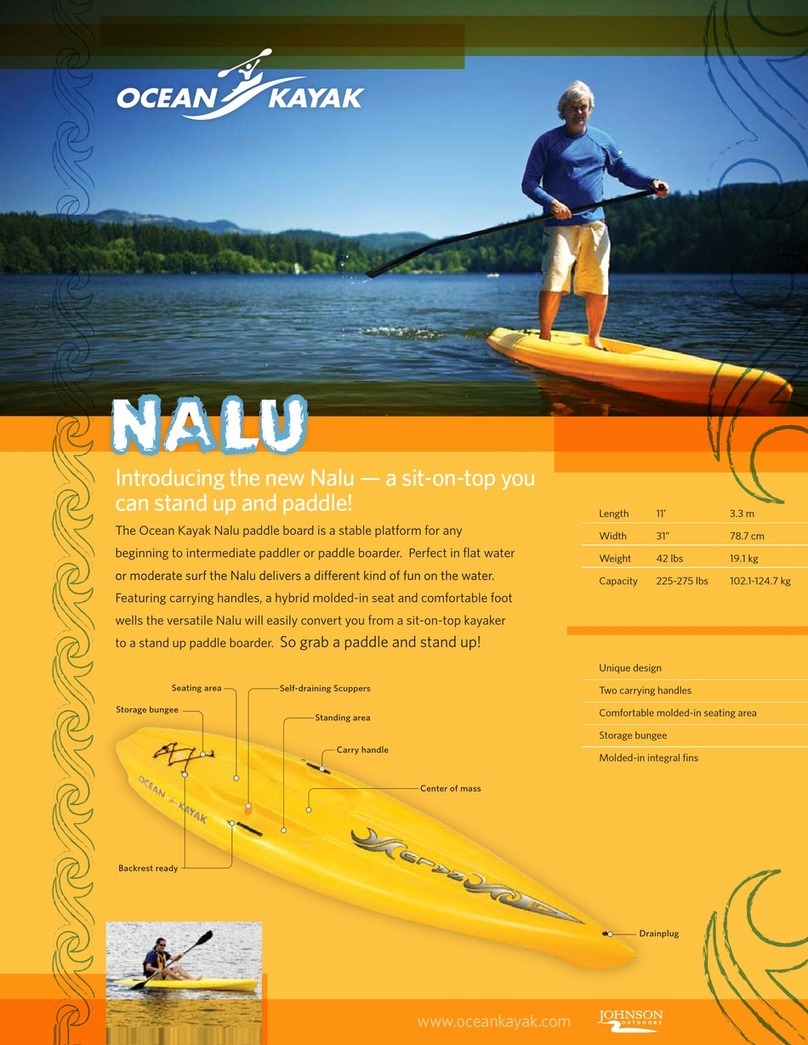
Ocean Kayak
Ocean Kayak Nalu brochure
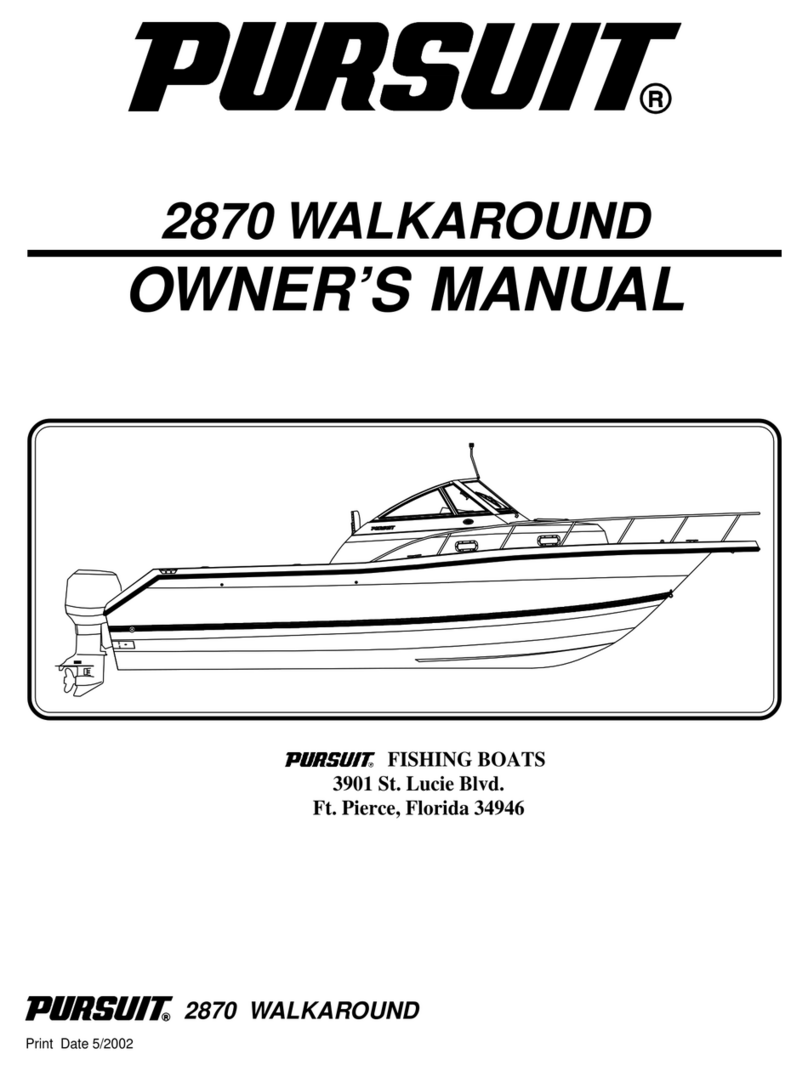
PURSUIT
PURSUIT 2870 Walkaround owner's manual
